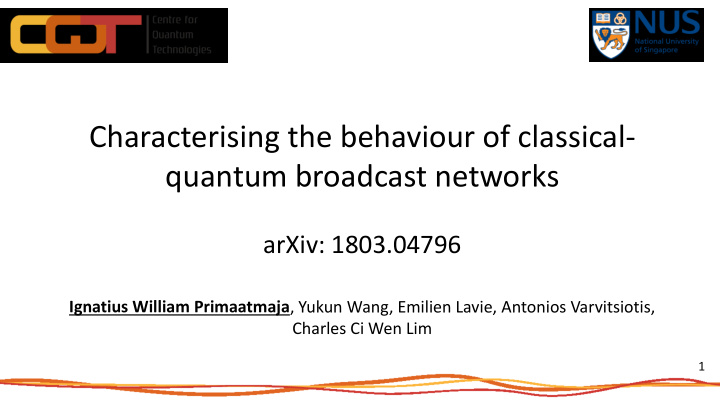



Characterising the behaviour of classical- quantum broadcast networks arXiv: 1803.04796 Ignatius William Primaatmaja , Yukun Wang, Emilien Lavie, Antonios Varvitsiotis, Charles Ci Wen Lim 1
Outline 1. Numerical toolbox for characterisation of the behaviour of classical-quantum broadcast network 2. Application: analysis of security of quantum key distribution (QKD) Phase encoding-BB84 protocol Time-bin encoding three-state protocol with coherent states 2
3
DEC Alice ENC Sender DEC Bob behaviour 4
separable measurements unitary operation projective measurements 5
What are the What are the behaviour allowed behaviour allowed by quantum by quantum physics? physics? No-cloning theorem Wooters-Zurek, Nature (1982) Information-disturbance trade-off Fundamental Fuchs & Peres, PRA (1996) constraints on the Horodecki et al, Found. Phys . (2005) correlations Indistinghuishability of non-orthogonal states Holevo, J. Multivariate Anal . (1973) 6
Born’s rule Born’s rule What are the What are the allowed allowed Inner Inner behaviour? behaviour? product product How do we do that How do we do that Do we need to find all Do we need to find all when the dimension when the dimension the states and the states and is unbounded? is unbounded? measurements that measurements that satisfy the constraints? satisfy the constraints? 7
We can consider semidefinite relaxations! Navascués-Pironio-Acín (NPA) method Problem solved for Problem solved for PRL (2007) the special case of the special case of NJP (2008) fixed source fixed source 8
Use a hierarchy of semidefinite relaxations with increasing number of Use a hierarchy of semidefinite relaxations with increasing number of constraints to obtain an outer approximation of the quantum set constraints to obtain an outer approximation of the quantum set 9
define inner- product constraints define probabilities constraints 10
Application: security analysis of quantum key distribution
Phase-encoding BB84 Huttner, Imoto, Gisin & Mor, PRA (1995) Alice Bob Eve parameter estimation basis key generation basis basis-independent 12
Apply the unitary transformation on the signal states Use Devetak-Winter bound and entropic Devetak-Winter, Proc. R. Soc. Lond. A (2005) uncertainty relation Berta et al, Nat. Phys. (2010) Maximise the phase error rate subject to the observed probabilities 13
Parameters: Parameters: Intrinsic optical error rate Intrinsic optical error rate = 2% = 2% Dark count rate = 1E-7 Dark count rate = 1E-7 Results using Lo- Preskill’s bound Lucamarini et al, PRX (2015) Sibson et al, Optica (2017) 14
Time-bin encoding three-state protocol Alice Bob D t data line IM D B laser D t D 0 bit 0 monitoring line bit 1 D 1 test state/decoy sequence Coherent-one-way protocols Stucki, Brunner, Gisin, Scarani & Zbinden, Appl. Phys. Letter (2005) Moroder, Marcos, Lim, Thinh, Zbinden & Gisin, PRL (2012) 15
Parameters: Parameters: Extinction ratio = d Extinction ratio = d Dark count rate = p dc Dark count rate = p dc Beam-splitter Beam-splitter transmittivity = t transmittivity = t 16
Summary • We propose an efficient SDP-based numerical toolbox to characterise quantum correlations in a broadcast network Independent of the dimension of system (thus, also works for coherent state encodings) Minimal assumptions about the measurement devices Applicable to any discrete prepare-and-measure protocols (not only in QKD) • We apply our method to analyse the security of quantum key distribution Higher secret key rate compared to previous results Highly versatile, can be used to analyse non-standard QKD protocol 17
On-going work and open problems • Analyse the security of distributed-phase-reference QKD protocols and discrete-modulated QKD protocols with homodyne/heterodyne detection • Consider different constraints (e.g. energy constraint) other than the inner- product constraints • Extend to measurement-device-independent (MDI) setups 18
Parameters: Parameters: Alignment error rate = 1.5% Alignment error rate = 1.5% Dark count rate = 8.5E-7 Dark count rate = 8.5E-7 Detector efficiency = 0.1 Detector efficiency = 0.1 Phase-encoding MDIQKD Tamaki et al, PRA (2012) 19
Full paper can be found here
Recommend
More recommend